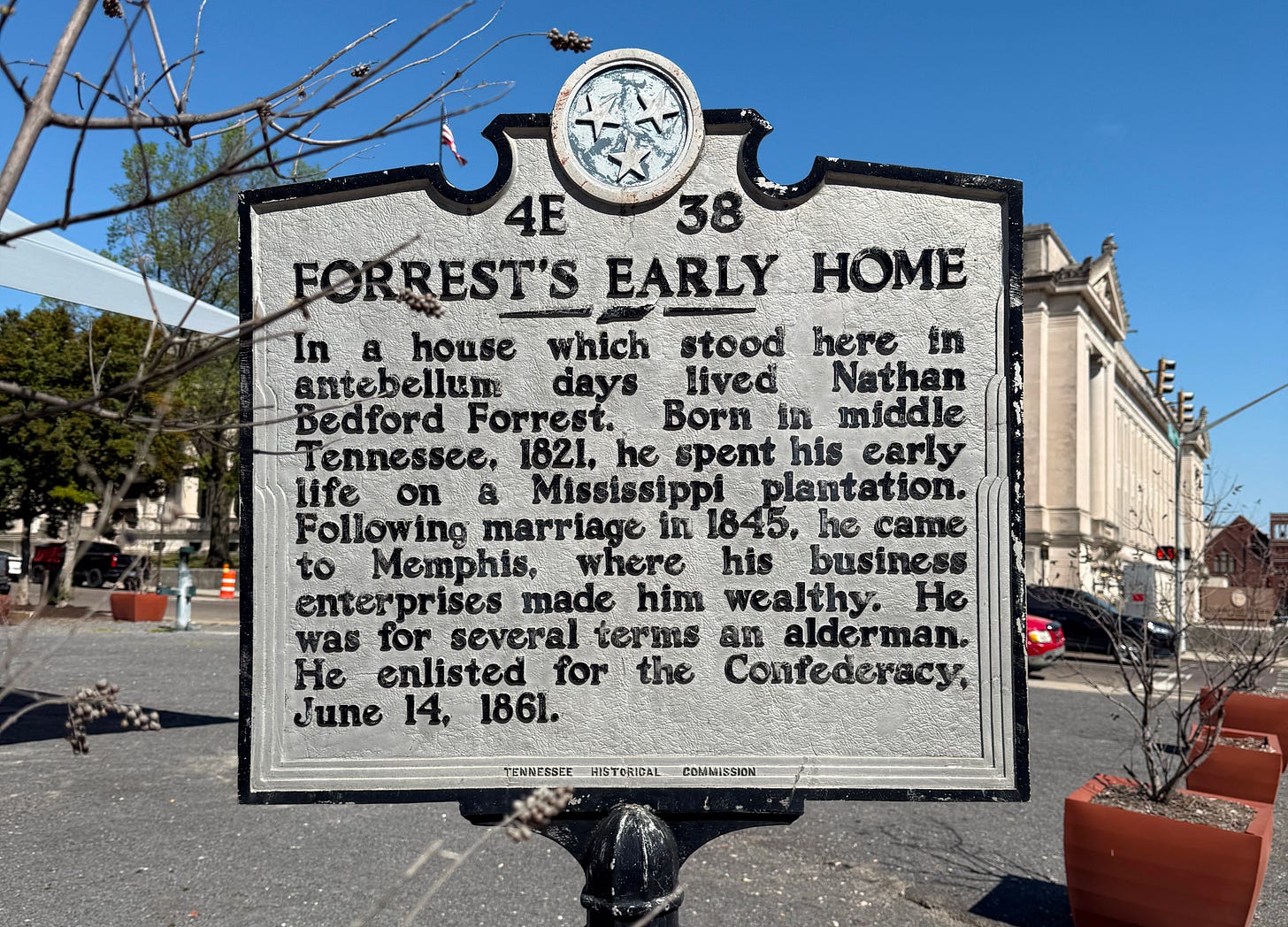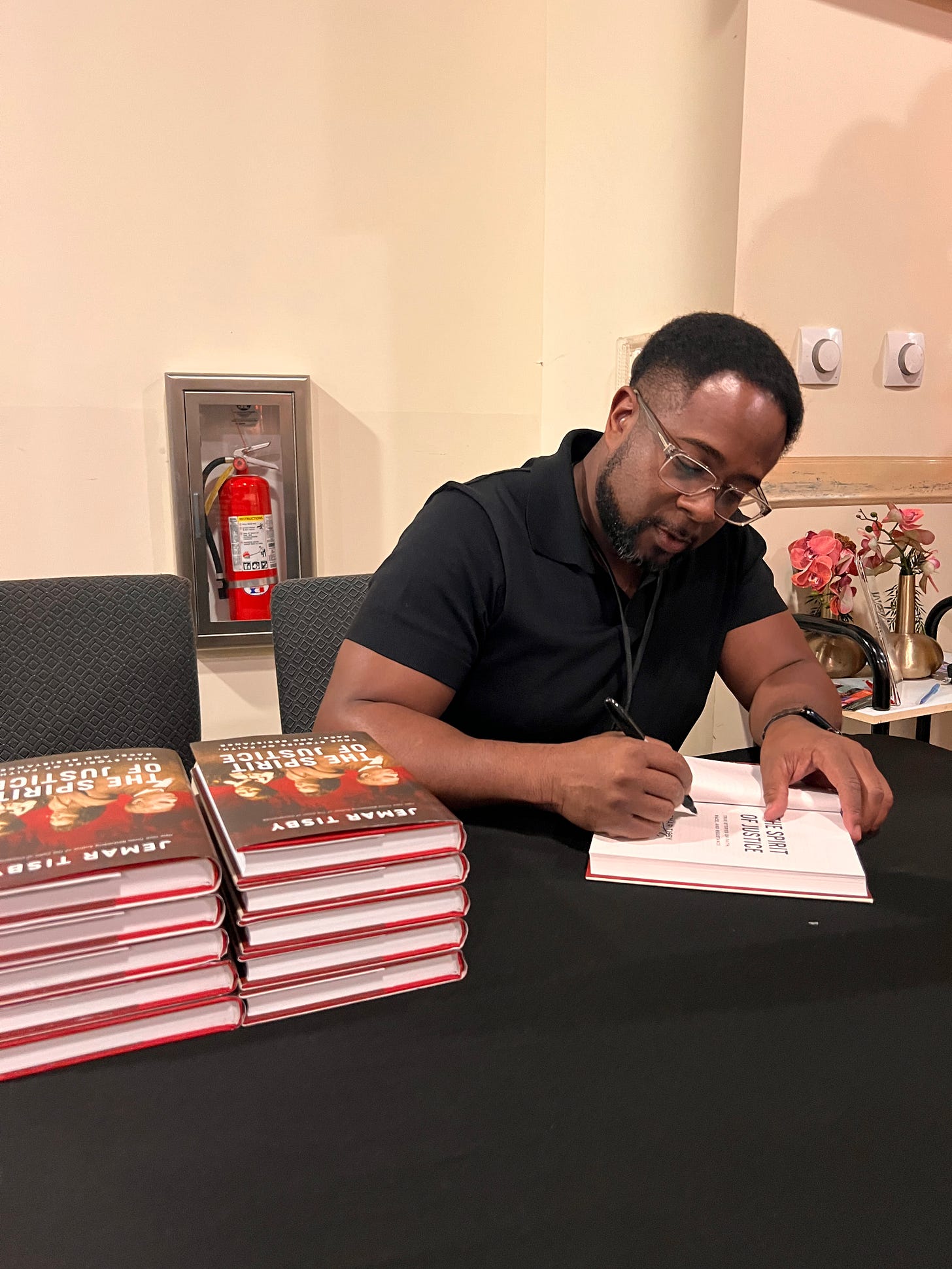Whitewashed History vs. Robust History
A side-by-side comparison of the Nathan Bedford Forrest historical markers in Memphis
This article came because I was able to take a trip to Memphis. There are so many fascinating historical sites around the nation, and my dream is to visit and write about more of them. I can do that with your help. Become a paid subscriber today!
Revered among pro-Confederate apologists and reviled by many others, especially African Americans, Nathan Bedford Forrest is one of the most well-known and controversial figures of the Civil War.
In Trump’s America, however, you would never know about any of that controversy.
A recently signed executive order titled, “Restoring Truth and Sanity to American History” promotes a whitewashed version of history instead of a robust history that tells a fuller story.
A side-by-side comparison of two historical markers dedicated to Nathan Bedford Forrest in Memphis, Tennessee tell the tale.
Forrest the Wealthy Slave Trader
Born in 1821, Nathan Bedford Forrest grew up in Mississippi and Tennessee in a poor family. His father died when he was just a teen and Forrest became the main breadwinner for his family.
Forrest didn’t stay poor for long.
Despite the lack of a formal education, he was entrepreneurial and action-oriented. As an adult he traded livestock, sold real estate, and sold human beings as property.
By the start of the Civil War, Nathan Bedford Forrest became a millionaire as a slave trader and one of the richest men in the entire South.
Forrest the Confederate General
During the war he enlisted as a private, but through a series of promotions, including a special consideration by the governor of Tennessee, he eventually rose to the rank of lieutenant general.
Forrest subscribed to the myth of white supremacy and lived out that belief with murderous force.
During the infamous Fort Pillow massacre in Tennessee on April 12, 1864, his troops murdered nearly 300 Union soldiers, many of whom were Black and were reportedly in the midst of surrendering.
“Remember Fort Pillow” became a rallying cry for Black Union soldiers for the rest of the war.
After the war, Forrest continued his white supremacist ways.
He served as the first grand wizard of the newly formed Ku Klux Klan and even had to testify before a Congressional committee about the groups domestic terrorist activities.
A Tale of Two Historical Markers
All of that is background for two historical markers that appear on the same corner in Memphis.
I recently visited there to be part of the Calvary Episcopal Church Lenten preaching series.
On the corner of the property of this historic church is where Forrest sold enslaved Black people who helped him make his millions.
An old historical marker still stands there and it reads as follows:
In a house which stood here in antebellum days lived Nathan Bedford Forrest. Born in middle Tennessee in 1821 he spent his early life on a Mississippi plantation. Following marriage in 1845, he came to Memphis, where his business enterprises made him wealthy. He was for several terms an alderman. He enlisted for the Confederacy, June 14, 1861.
On this historical marker posted by the Tennessee Historical Commission, the phrase “business enterprises” is covering up the fact that Nathan Bedford Forrest business was selling enslaved men, women, girls, and boys.
Not a word about his rebellion against the Union, the Fort Pillow massacre or his leadership of the KKK.
Just an innocuous message about a prominent man who moved to Memphis, fought for the Confederacy, and for some reason deserves a historical marker.
Contrast that earlier marker with a later one erected in 2018 in cooperation with current leadership at Calvary Memphis.
The data contained in the updated marker is so thorough it had to be in smaller font and continued on two sides.
In the very first sentence of the revised marker, installed in 2018, it states that Forrest “operated a profitable slave trading business at this site.”
No mincing words or softening the brutality of his business in human flesh.
The marker also goes on to provide historical and local context for the slave trade. Memphis repealed a ban on trading enslaved people in 1855 when the profitability of the practice outweighed the humanity of the enslaved.
The marker also names one of the victims of the Forrest’s slave trade—Horatio Eden, “sold from Forrest’s yard as a child.”
Eden later recalled:
We were brought out and paraded two or three around a circular brick walk in the center of the stockade. The buyers would stand nearby and inspect us as we went by, stop us, and examine us.”
The historical marker also explains Nathan Bedford Forrest’s particular brand of greed.
“While his business practices mostly resembled those of other traders in town, Forrest uniquely engaged in the buying and selling of Africans illegally smuggled into the United States, in violation of an 1808 congressional ban.”
The newer historical marker includes a message about memory and myth-making.
"In the decades after the Civil War, many white southerners chose to portray Forrest as a military hero, thus excusing or ignoring Forrest’s buying and selling of human beings.
The groups behind the updated marker include: Calvary Episcopal Church, Rhodes College, and the National Park Service.
Whitewashed History vs. Robust History
This is what Trump and the far-right mean by “revisionist history.”
All history is revised when new information becomes available or when the culture shifts enough to tell a more truthful story about the past.
In his executive order, Trump wants more markers like the sanitized one that erases the history of racism and white supremacy in favor of a valorous tale of manly, wealthy men who became courageous warriors in pursuit of a noble cause.
Nothing could be further from the truth.
Erasing the ugly parts of history doesn’t make the past less brutal—it just makes the present more dangerous.
What’s a myth about American history you used to believe? Let us know in the comments!
Remember to register for our LIVE online launch event for “Roadmap to Ruin: How the Church Can Resist the Dismantling of Democracy.” Thursday, April 3 at 7 pm ET.
If you want ROBUST history, check out my latest book The Spirit of Justice: True Stories of Faith, Race, and Resistance.








Thank you, Dr. Tisby. What a *perfect* object lesson to illustrate just what’s at stake. Funny thing: it always seemed to me that telling the whole story, as the second marker does, WAS restoring truth and sanity to history.
Thank you for this, this morning. When I was younger, I wasn't very historically minded and there was so much I was ignorant of concerning history until I began to hit the books in my late 40's [and some other media, but mostly books]. In my early 20's, someone who I believed knew more and who I respected told me the Civil War was actually about state's rights and I believed him. That got corrected later, but it reminds me of how ignorance leaves us vulnerable to false narratives.